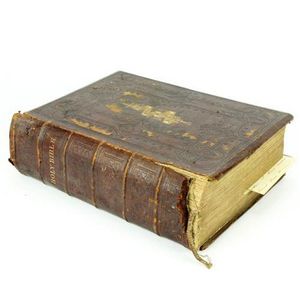Cedar Writing Slope by J. Greaves, Cabinet Maker
You must be a subscriber, and be logged in to view price and dealer details.
Subscribe Now to view actual auction price for this item
When you subscribe, you have the option of setting the currency in which to display prices to $Au, $US, $NZ or Stg.
- Rosewood - A dense timber that varies in shade to very light brown to almost black. When rosewood is cut and sanded the colour of the timber will turn black, and after polishing and exposure to daylight, the surface will gradually lighten over time to light brown with black streaks.
The name comes from the odour emanating from the timber when it is planed, sanded or cut.
Rosewood was very popular for use in Victorian furniture in the second half of the 19th century, and at that time most of the rosewood was imported from Brazil. However it also grows in India and Indonesia.
It is used in the sold for chairs and table legs, but for carcase furniture such as side cabinets and bookcases, and for table tops it is always used as a veneer. - Veneers - Veneers are thin sheets of well-figured timber that are glued under pressure to the surface of a cheaper timber for decorative effect, and then used in the making of carcase furniture.
Early veneers were saw-cut so were relatively thick, (up to 2 mm) but is was realised that saw cutting was wasteful, as timber to the equivilent of the thickness of the saw was lot on each cut.
A more efficient method was devised to slice the timber, either horizontally with a knife, or in a rotary lathe.
Flame veneer, commonly found in mahogany or cedar furniture, is cut from the junction of the branches and main trunk. So-called fiddleback veneers, where the grain is crossed by a series of pronounced darker lines, is usually cut from the outer sections of the tree trunk.
During the 17th and 18th centuries, and in much of the walnut marquetry furniture made during the latter part of the 19th century, the veneer was laid in quarters, each of the same grain, so that one half of the surface was the mirror image of the other.
The use of veneer allows many other decorative effects to be employed, including stringing, feather banding, cross banding, and inlaid decorative panels in the piece. The carcase over which veneer is laid is usually of cheaper timber such as pine, oak or, sometimes in Australia during the first half of the 19th century, red cedar.
The important thing to remember about veneers is that prior to about 1850 they were cut by hand, and were consequently quite thick - ranging up to about 2mm deep.
From the mid-19th century veneers were cut by machines and were almost wafer-thin. This is a critical point when trying to judge the approximate age of veneered furniture.
This item has been included into following indexes:
- cabinets, material
- cabinets, period or style - Colonial 112
Visually similar items

A contemporary coffee table, manufactured by 'Mortise and Tenon'. 170 cm wide, 130 cm deep

Victorian holy bible with marginal readings & parallel references and the Commentaries of Henry Scott, with a series of illustrations in chromo lithograph, by William Collins, Sons & Co, Glasgow, London & Edinburgh. Condition good to fair, damage to the sp

Wooden box, filing box, money box or writing slope

A Victorian birds-eye maple writing slope, with decorative edge to the hinged lid. 30 cm x 21 cm x 13 cm
